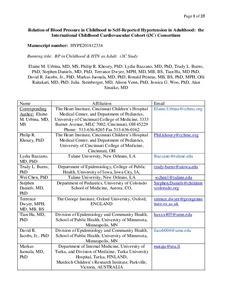Relation of Blood Pressure in Childhood to Self-Reported Hypertension in Adulthood: The International Childhood Cardiovascular Cohort Consortium
Juonala M; Woo JG; Khoury PR; Prineas R; Daniels S; Bazzano L; Jacobs DR; Burns TL; Dwyer T; Urbina EM; Sinaiko A; Steinberger J; Raitakari O; Hu T; Venn A
Relation of Blood Pressure in Childhood to Self-Reported Hypertension in Adulthood: The International Childhood Cardiovascular Cohort Consortium
Juonala M
Woo JG
Khoury PR
Prineas R
Daniels S
Bazzano L
Jacobs DR
Burns TL
Dwyer T
Urbina EM
Sinaiko A
Steinberger J
Raitakari O
Hu T
Venn A
LIPPINCOTT WILLIAMS & WILKINS
Julkaisun pysyvä osoite on:
https://urn.fi/URN:NBN:fi-fe2021042826538
https://urn.fi/URN:NBN:fi-fe2021042826538
Tiivistelmä
Blood pressure (BP) tracking (maintaining a BP percentile) across life is not well defined but is important in predicting which children will become hypertensive adults. We computed BP tracking in subjects with BP measured in childhood and adulthood and performed logistic regression to determine the ability of childhood BP to predict adult hypertension (N=5035, 46.7 years, 74.2% white, 17.7% black; 39.6% male). Prevalence of hypertension was 29%. Correlations between systolic BP for child and adolescent were r=0.48; for adolescent and young adult were r=0.40, and for child and young adult were r=0.24 (all P<0.0001). Participants self-reporting adult hypertension were less likely to be white (38.7% black, 27.6% white, 20.9% other; P<0.0001) and female (26.4% females, 32.9% male, P<0.0001). Participants with adult hypertension were more likely to have higher BP and adiposity by age 10 years and abnormal lipids and glucose by age 16 years. There was a graded increase in the frequency of self-reported adult hypertension across the BP change groups, even within the persistently normotensive group (X-2<0.0001) from 19% in children with a systolic BP% persistently below the median to 80% for individuals with elevated BP in both childhood and adolescence. Although our precision to predict which individual child is at risk of adult BP-related cardiovascular disease is weak, an increase in systolic BP and body mass index percentile from childhood to adolescence should signal a need for lifestyle intervention to prevent future sustained hypertension-related cardiovascular disease.
Kokoelmat
- Rinnakkaistallenteet [19207]
